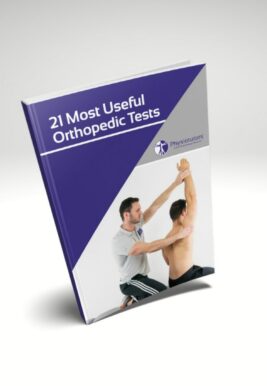Learn
Ischiofemoral Impingement Test | Ischiofemoral Hip Impingement
Posterior hip pain remains a challenge for clinicians. The following graphic from a paper by Gomez-Hoyos et al. (2018) shows an overview of possible competing diagnoses:

As you can see, differential diagnosis in the posterolateral hip region is not that straightforward.
In 1977 ischiofemoral impingement, abbreviated as IFI, was first described by Johnson and still remains a disputed entity. Unlike femoroacetabular impingement that you know from the CAM and pincer deformity, IFI is an extraarticular form of impingement. Torriani et al. (2009) defined the syndrome as a decrease in ischiofemoral space between the lateral ischium and the minor trochanter and a decreased quadratus femoris space between the minor trochanter and the proximal hamstring tendons.

Patients often complain about long-stride walking pain. The pain is felt lateral to the ischium during the toe-off/preswing phase of gait with the hip in terminal extension in which position the lesser trochanter rubs the lateral border of the ischium or the semimembranosus tendon origin. Some patients also complain about radiating pain down the ipsilateral leg which could be elicited when the sciatic nerve becomes entrapped in the ischiofemoral space.
Goméz-Hoyos et al. (2016) evaluated the accuracy of the ischiofemoral impingement test and found a sensitivity of 82% and a specificity of 85%. The gold standard they used was a combination of posterior hip pain, abnormal MRI findings including a reduced ischiofemoral space or quadratus femoris space) and at least 60% pain relief after decompression surgery. This is the only study so far and it was done in a retrospective study design which might have missed patients who did not undergo injection or surgery. Additionally, the study did not determine the intra- or interobserver reliability of this test. For this reason, the clinical value of this test remains questionable for now.
To perform the test, the patient is in side-lying position on the unaffected side. The examiner palpates the lateral ischium with one hand while the other brings the affected hip into maximal extension with the hip in adduction or neutral position in an attempt to provoke symptoms. If familiar posterior hip pain is reproduced the test is repeated with the hip in abduction, which should not reproduce symptoms. This test is positive if the familiar posterior hip pain is reproduced in the first position and cannot be reproduced in the second testing position.
21 OF THE MOST USEFUL ORTHOPAEDIC TESTS IN CLINICAL PRACTICE

Another orthopedic test that assesses for ischiofemoral hip impingement is the long stride walking test.
References
Like what you’re learning?
BUY THE FULL PHYSIOTUTORS ASSESSMENT BOOK
- 600+ Pages e-Book
- Interactive Content (Direct Video Demonstration, PubMed articles)
- Statistical Values for all Special Tests from the latest research
- Available in 🇬🇧 🇩🇪 🇫🇷 🇪🇸 🇮🇹 🇵🇹 🇹🇷
- And much more!








